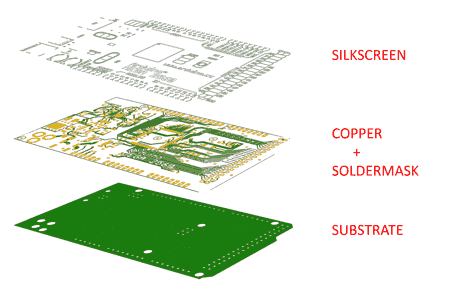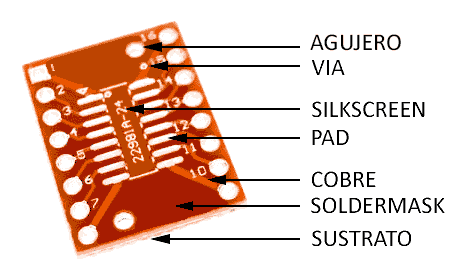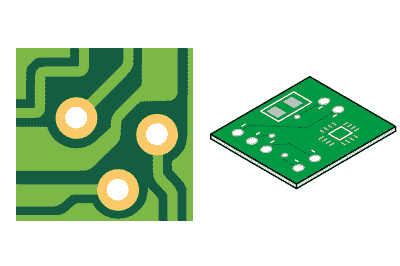Second entry of this new section dedicated to designing our own PCBs, where we are going to see the parts that make up a PCB and their function in the electronic circuit they form.
In the first introductory entry, we saw what a PCB is and how having our own custom PCB is not so difficult and is a way to have professional, simple, and robust assemblies for our projects.
In this post, we will see the parts that make up a PCB and their functionality, and we will introduce some vocabulary that we will frequently encounter when we get into this great “world” of PCBs.
So we start with the support, the most visible part of a PCB. The support is the body of the PCB, it is “what we touch”. The thickness is usually between 0.8 to 1.6mm. This insulating substrate base serves to support the components and the conductive circuits, and isolate them from each other.
On the support, there are one or more very very very thin layers of conductive material (of the order of hundredths of mm), usually copper. These layers are configured into tracks that make up the circuits, usually by removing certain parts from a continuous copper layer.

The tracks are “little paths” of conductive material that connect the electronic components that we mount on the PCB and “act as cables”. Together, PCB and components form the electronic circuit.
As we have advanced, it is possible to have more than one layer of copper. In fact, normally we will have two layers, one on each side of the PCB. But it is possible to have more layers, within the PCB itself. We will see all this in more detail in the next entry, on PCB layers.
The copper layers are insulated and protected with a layer of lacquer (Soldermask). This lacquer is what gives the characteristic color to the board, with green, white, red, black, and blue being common colors.

For example, in the previous image, we have two shades of red. The light parts are where there is copper underneath, while the dark parts do not, and the Soldermask is applied directly to the substrate.
On the other hand, we have Pads, which are areas where we are going to mount components. In these areas, the Soldermask is not applied, so the copper is “exposed”. Sometimes they are given a subsequent treatment, for example, with tin.
In the case of PTH components, the Pads are holes with a part of copper around them (like the holes on both sides in the photo). In the case of SMD components, the pads are simply a piece of uncovered conductor (like the one indicated by the arrow).
Another essential component is Vias, which are small holes in the PCB that serve to vertically connect the conductor layers. They should not be confused with PTH Pads, although visually they are similar, but with a smaller diameter. We will also see them in an upcoming entry.
It is also common to find holes without copper or any electrical function. They can be round or any other shape. We will use them, for example, to screw the PCB, make way for a cable, or for another component.
Finally, we have paint layers (silkscreen) where we can put drawings and texts. For example, the silhouette of the components, their names, indications, instructions, the model of the board, logos, etc.
So far this introductory entry on the parts that make up a PCB. It is advisable to get used to the vocabulary because it is what you will find in design programs and what we will use in the rest of the section.
In the next entry, we will continue to see in more depth the topic of conductor layers, and in the following entry, we will see the vias. See you soon!
